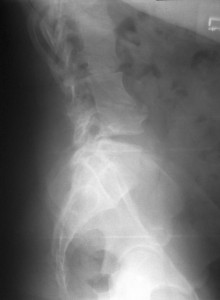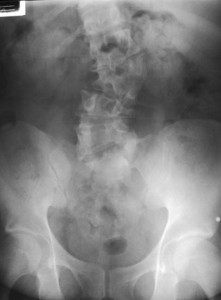Hemivertebrae
(From the March 2011 The “G”Note)
Case Report: Hemivertebrae
A 22-year-old male presented to our office on January 25, 2002, with acute low back pain. He stated that he had soreness most of the time but not this “sharp pain.” The lumbar spine had restricted ROM, pain exacerbated by flexion, right and left lateral bending. AP x-rays revealed hemivertebrae—the lateral x-rays demonstrated block vertebrae. There was a “c-shaped” deformity of the anterior surface of the block vertebrae—a “wasp-waist” appearance. Rudimentary osteophytes were present. There was a remnant disc at L3-4, but normal disc spacing at L4-5. L4 was the subluxation, PRI-M listing.
L4 was adjusted side posture on the pelvic bench. After four adjustments, the acute pain subsided. His low back pain is chronic, and care is sought when he has acute episodes. He averages 2-3 visits annually.
New x-rays were taken on January 29, 2010. The AP x-ray remained basically the same. The lateral x-ray demonstrated further growth of the osteophytes. The
new films reveal a shotgun pellet. I asked him if he’d eaten wild game recently. He stated that he ate rabbit the previous day. Pellets on x-rays are common in our area due to hunting.
Hemivertebrae constitute approximately six percent of anomalies associated with congenital spinal deformities. When one of the lateral ossification centers fails to grow, the result is a triangular deformity of the vertebral body called “lateral hemivertebrae.” A hemivertebra usually doesn’t exist singularly; other anomalies are usually present. The appearance of hemivertebrae is quite characteristic and may be diagnosed from the AP film. Multiple hemivertebrae with block vertebrae distort the appearance of the spine and is referred to as scrambled spine.
His prognosis is guarded. His job requires working on concrete and involves repetitive bending and lifting. For now, the adjustments reduce his pain. If he doesn’t change vocations, I suspect that his condition will worsen.
AP and lateral films dated December 29, 2010


